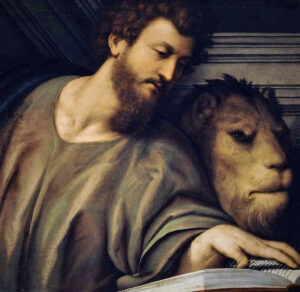From the Rector
Recent Messages from Our Rector
The Feast of St. Mary the Virgin, Mother of our Lord Jesus Christ
August 15, 2022
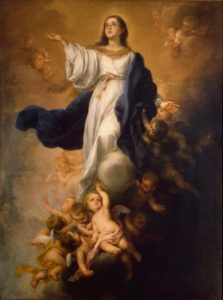
Today, August 15th, the Church celebrates the feast of St. Mary the Virgin, Mother of our Lord Jesus Christ. We honor her as the first Saint of the Church. She was the closest to Jesus starting with the Annunciation, his Nativity in Bethlehem, through his glorious Passion. We also revere her for her courage. Mary remained at the cross with her Son at great risk to herself when others fled for fear of the Romans. She was a mother until the end.
In the West and the East, the Churches have ascribed much to her, which is not always supported by the Holy Bible. However, Episcopalians honor her for her intimate relationship with the incarnate Son of God and her integral part in the salvation narrative.
The Collect for St. Mary the Virgin
O God, you have taken to yourself the blessed Virgin Mary, mother of your incarnate Son: Grant that we, who have been redeemed by his blood, may share with her the glory of your eternal kingdom; through Jesus Christ our Lord, who lives and reigns with you, in the unity of the Holy Spirit, one God, now and for ever. Amen.
The Magnificat
My soul proclaims the greatness of the Lord,
my spirit rejoices in God my Savior; *
for he has looked with favor on his lowly servant.
From this day all generations will call me blessed: *
the Almighty has done great things for me,
and holy is his Name.
He has mercy on those who fear him *
in every generation.
He has shown the strength of his arm, *
he has scattered the proud in their conceit.
He has cast down the mighty from their thrones, *
and has lifted up the lowly.
He has filled the hungry with good things, *
and the rich he has sent away empty.
He has come to the help of his servant Israel, *
for he has remembered his promise of mercy,
The promise he made to our fathers, *
to Abraham and his children for ever.
Glory to the Father, and to the Son, and to the Holy Spirit: *
as it was in the beginning, is now, and will be for ever. Amen.
Appointed Lessons and Psalm
Isaiah 61:10–11
Psalm 34
Galatians 4:4–7
Luke 1:26–38
The Feast of St. Mary Magdalene
July 22
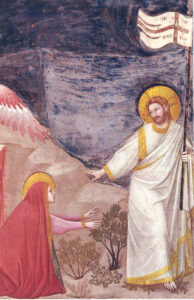
Mary of Magdala, a town near Capernaum, was one of several women who followed Jesus and ministered to him in Galilee. The Gospel according to Luke records that Jesus “went on through cities and villages, preaching and bringing the good news of the kingdom of God. And the Twelve were with him, and also some women who had been healed of evil spirits and infirmities: Mary, called Magdalene, from whom seven demons had gone out …” (Luke 8:1–2). The Gospels tell us that Mary was healed by Jesus, followed him, and was one of those who stood near his cross at Calvary.
It is clear that Mary Magdalene’s life was radically changed by Jesus’ healing. Her ministry of service and steadfast companionship, even as a witness to the crucifixion, has, through the centuries, been an example of the faithful ministry of women to Christ. All four Gospels name Mary as one of the women who went to the tomb to mourn and to care for Jesus’ body. Her weeping for the loss of her Lord strikes a common chord with the grief of all others over the death of loved ones. Jesus’ tender response to her grief—meeting her in the garden, revealing himself to her by calling her name—makes her the first witness to the risen Lord. She is given the command, “Go to my brethren and say to them, I am ascending to my Father and your Father, to my God and your God” (John 20:17). As the first messenger of the resurrection, she tells the disciples, “I have seen the Lord” (John 20:18).
In the tradition of the Eastern Church, Mary is considered “equal to the apostles” and “apostle to the apostles”; and she is held in veneration as the patron saint of the great cluster of monasteries on Mount Athos (Lesser Feasts and Fasts 2018 pp. 316-317).
The Collect of St. Mary Magdalene
Almighty God, whose blessed Son restored Mary Magdalene to health of body and of mind, and called her to be a witness of his resurrection: Mercifully grant that by your grace we may be healed from all our infirmities and know you in the power of his unending life; Through the same Jesus Christ our Lord, who with you and the Holy Spirit lives and reigns, one God, now and for ever. Amen.
Appointed Lessons and Psalm
Judith 9:1–4, 10–14
Psalm 42:1–7 2
Corinthians 5:14–18
John 20:11–18
Independence Day
July 4

Dear Friends,
Our celebration of Independence Day is a secular national holiday, but it is also a major feast in the Episcopal Church. One would think this has been the case since the birth of our nation, but it was not.
Prior to the American Revolution, Anglican clergy were required to swear an oath of allegiance to the Crown of Great Britain. A solid majority of colonial clergy were in favor of increased self-governance, but they also strongly favored retaining ties to the Crown. When our nation obtained full independence, there was an enormous flight of clergy to Great Britain, and those remaining behind held private misgivings about the severed ties with the King.
During the General Convention of the Episcopal Church in 1786, there were resolutions to draft and incorporate prayers celebrating our nation’s birth in the new American Book of Common Prayer. However, The Rt. Rev. William White, a proponent of the Revolution, felt it was “unwise.” He feared it would be too divisive given the private misgivings many clergy and church members held. It wasn’t until the 1928 Book of Common Prayer was ratified that Independence Day was fully recognized as a major feast of the Episcopal Church!
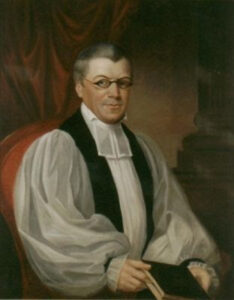 However in 1826, Bishop John Henry Hobart, of New York authorized the printing and use of devotions celebrating American Independence in his diocese. In addition, he authored several articles defending the nature of Anglicanism in the United States. He was able to articulate and defend the practice of Anglicanism without the protection and influence of the Crown. His thesis was truly revolutionary!
However in 1826, Bishop John Henry Hobart, of New York authorized the printing and use of devotions celebrating American Independence in his diocese. In addition, he authored several articles defending the nature of Anglicanism in the United States. He was able to articulate and defend the practice of Anglicanism without the protection and influence of the Crown. His thesis was truly revolutionary!
Today, Bishop Hobart’s influence is found everywhere in the Episcopal Church. He founded General Theological Seminary and Hobart College. Also, his name springs up across the plains of the Midwest and much more. His writings influenced me as a seminarian, and I give thanks for his zeal for the apostolic Church, and his unique vision to preserve it in the new, free, and independent United States of America.
Sincerely yours,
Copeland+
The Nativity of St. John the Baptist
June 24th
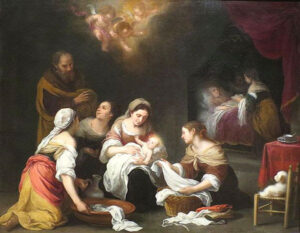
Today, the Church commemorates and solemnizes the birth of St. John the Baptist. He is called the precursor of Christ, the one foretold in scripture, to prepare the way of His coming. John the Baptist is also the cousin of our Lord through his Mother’s lineage. As we read in the Gospel according to St. Luke, he was born six months before Jesus. So, the world of retail will now remind us that Christmas is only 6 months away!
St. John the Baptist held populist sway despite his strong declarations to repent and turn one’s orientation away from the world of sin. Despite his rockstar status, he was emphatic that he must decrease and God in Christ must increase! Of course, according to St. John the Baptist, if one is converted to Christ in this way, they must produce fruits worthy of repentance; otherwise, the stones are of more value to God than those who are literally and spiritually descendants of Father Abraham.
Collect of the Nativity of St. John the Baptist
Almighty God, by whose providence your servant John the Baptist was wonderfully born, and sent to prepare the way of your Son our Savior by preaching repentance: Make us so to follow his teaching and holy life, that we may truly repent according to his preaching; and, following his example, constantly speak the truth, boldly rebuke vice, and patiently suffer for the truth’s sake; through Jesus Christ your Son our Lord, who lives and reigns with you and the Holy Spirit, one God, for ever and ever. Amen
Appointed Lessons and Psalm
Isaiah 40:1–11
Psalm 85
Acts 13:14b–26
Luke 1:57–80
June 19, 2022 
Dear Friends,
Last Sunday we started a new liturgical season, the “Season After Pentecost,” or “Ordinary Time” as others call it. The season starts with Trinity Sunday and ends with the first Sunday in Advent. During this season we revisit the stories of our Salvation as they pertain to our new life in Jesus Christ. It is a season of new hope in full anticipation of Christ’s coming again. He fulfilled his Easter promise, and as Christians, we trust his promise that he will come again.
The color of this season is green. Green represents anticipation and newness. The earth teaches us the benefits of newness in God as we watch for the green sprigs of the field in anticipation of the coming harvest. All of creation gives glory to our Creator and directs our attention to Him and to things eternal. We’re fortunate to live in this beautiful part of the world where the abundance of the earth surrounds us to sustain our lives and make our hearts glad. Here the creeks and rivers flow to the seas and gives life to the soil and the creatures below, the trees draw our orientation upward to the eternal expanse above us, and the rush of the wind speaks with the mystery of Him who breathed new life into our first parents. Apart from earth’s natural wonders, this season is also a time for our refreshment and re-creation.
I wish you all a safe, happy, and GREEN Ordinary Time.
Your friend in Christ,
Copeland+
June 2, 2022 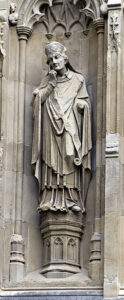
“Veni Sancti Spiritus”
Dear Friends in Christ,
Veni Sanctus Spiritus is the title of a historic and popular prayer in the Church. Translated from Latin to English it means “Come Holy Spirit.” The prayer was written by the Archbishop of Canterbury Stephen Langton (see picture of statue) around the year 1200 and is commonly called “The Veni.” It has been used for centuries in public worship and private devotions.
The prayer was later added to music and was regularly sung as a sequence hymn to the reading of the Holy Gospel during a liturgy. Today, in the Episcopal Church, a version of The Veni is sung or said before a bishop lays hands on candidates for Holy Orders to make them deacons and priests.
This coming Sunday, we will read a lesson from Acts 2:1-21. We will hear the following segment from the lesson: “and suddenly from heaven there came a sound like the rush of a violent wind, and it filled the entire house where they were sitting.” To recreate that first Day of Pentecost, it became a tradition in Christian households to open doors and windows and recite The Veni as a way to invite the wind of the Holy Spirit into one’s home.
I am including this prayer in my message today as an invitation for you to use it domestically as a way to invite the Holy Spirit into your homes anew this Pentecost. I hope it will inspire in you a deeper devotion to Jesus Christ through the power of His gift, the Holy Spirit.
Your friend in Christ,
Copeland+
Veni Sancti Spiritus
Come, O Holy Spirit, come!
From your bright and blissful
Home
Rays of healing light impart.
Come, Father of the poor,
Source of gifts that will endure
Light of ev’ry human heart.
You, of all consolers best,
Of the soul, most kindly Guest,
Quick’ning courage do bestow.
In hard labor You are rest,
In the heat You refresh best,
And solace give in our woe.
O most blessed Light divine,
Let Your radiance in us shine,
And our inmost being fill.
Nothing good by man is thought,
Nothing right by him is wrought,
When he spurns Your gracious Will.
Cleanse our souls from sinful stain,
Lave our dryness with Your rain
Heal our wounds and mend our way.
Bend the stubborn heart and will,
Melt the frozen, warm the chill,
Guide the steps that go astray.
On the faithful who in You,
Trust with childlike piety,
Deign your sevenfold gift to send.
Give them virtue’s rich increase,
Saving grace to die in peace,
Give them joys that never end.
Amen. Alleluia.
|
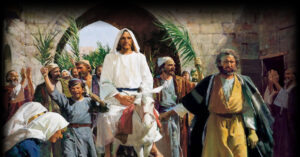
Palm Sunday
April 10
The holiest week in Western Christianity begins this Sunday with our celebration of Palm Sunday. Throughout the season of Lent we’ve learned the stories of Jesus making his way to Jerusalem. We recall this Palm Sunday his triumphal entry into the city as people shout “hosanna!” and make other gestures of adoration, only to be betrayed by one of his disciples. He is then stripped away from us on Maundy Thursday after demonstrating loving service and endowing the Church with his Real Presence in the Holy Eucharist. We then survey the wondrous cross on Good Friday. It is upon Golgotha’s Hill Jesus gives his life for the life of the world. Throughout his gruesome and horrific Passion and crucifixion, his mother, St. Mary, never leaves him. She is a faithful mother and servant to the bitter end.
On Easter, the third day, Mary Magdalene arrives at the tomb and finds it empty. Weeping, a voice said to her, “woman, why are you crying?” She turned to realize it was our risen Lord! As he promised, he rose from the dead! Through Holy Baptism, we now share in his Passion, death and Resurrection. This means we are joint heirs of eternal life through Jesus Christ!
The stories and liturgies will be intense, but I pray they will be meaningful to us as we remember the great drama of our redemption. I wish you all a blessed Holy Week.
The Annunciation of Our Lord Jesus Christ to the Blessed Virgin Mary
March 25th
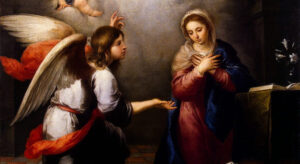
Pour your grace into our hearts, O Lord, that we who have known the incarnation of your Son Jesus Christ, announced by an angel to the Virgin Mary, may by his cross and passion be brought to the glory of his resurrection; who lives and reigns with you, in the unity of the Holy Spirit, one God, now and for ever. Amen.
“Today’s feast commemorates how God made known to a young Jewish woman that she was to be the mother of his Son. The Annunciation has been a major theme in Christian art, in both East and West, and innumerable sermons and poems have been composed about it. The term coined by Cyril of Alexandria for the Blessed Virgin, Theotokos (“the God-bearer”), was affirmed by the General Council of Ephesus in 431.
Many theologians stress that Mary accepted her vocation with perfect conformity of will. Mary’s self-offering in response to God’s call has been compared to that of Abraham, the father of believers. Just as Abraham was called to be the father of the chosen people, and accepted his call, so Mary was called to be the mother of the faithful, the new Israel. She is God’s human agent in the mystery of the Incarnation. Her response to the angel, “Let it be to me according to your word,” is identical with the faith expressed in the prayer that Jesus taught: “Your will be done on earth as in heaven.”
[Our] salvation is only possible because of Mary’s free cooperation with God in that salvation. It has been said, “God made us without us, and redeemed us without us, but cannot save us without us.” Mary’s assent to God’s call opened the way for God to accomplish the salvation of the world. It is for this reason that all generations have called her “blessed.” ” (taken from Lesser Feasts & Fasts 2018, p. 150)
Lessons and Psalm
The Feast of St. Joseph
March 19
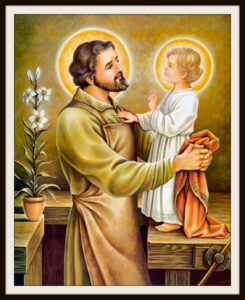
Today, we remember the faithfulness of St. Joseph, carpenter, father, guardian, and man of faith.
O God, who from the family of your servant David raised up Joseph to be the guardian of your incarnate Son and the spouse of his virgin mother: Give us grace to imitate his uprightness of life and his obedience to your commands; through Jesus Christ our Lord, who lives and reigns with you and the Holy Spirit, one God, for ever and ever. Amen.
In the face of circumstances that distressed even a man of such tenderness and obedience to God as Joseph, he accepted the vocation of protecting Mary and being a father to Jesus. He is honored in Christian tradition for the nurturing care and protection he provided for the infant Jesus and his mother in taking them to Egypt to escape Herod’s slaughter of the innocents, and in rearing him as a faithful Jew at Nazareth. The Gospel according to Matthew pictures Joseph as a man of deep devotion, open to mystical experiences, and as a man of compassion, who accepted his God-given responsibility with gentleness and humility.
Joseph was a pious Jew, a descendant of David, and a carpenter by trade. As Joseph the Carpenter, he is considered the patron saint of the working man, one who not only worked with his hands, but taught his trade to Jesus. The little that is told of him is a testimony to the trust in God which values simple everyday duties, and gives an example of a loving husband and father. (Lesser Feasts & Fasts p. 192)
Lessons and Psalm

